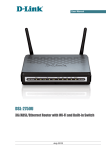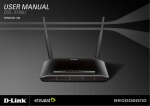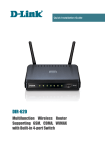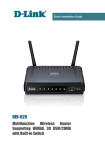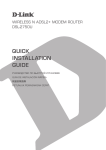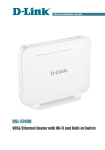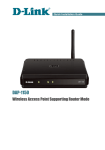Download D-Link DSL 2750U Installation guide
Transcript
Quick Installation Guide DSL-2750U/NRU 3G/ADSL/Ethernet Router with Wi-Fi and Built-in Switch DSL-2750U/NRU Quick Installation Guide BEFORE YOU BEGIN Delivery Package • Router DSL-2750U/NRU • Power adapter • RJ-11 telephone cable • Straight-through Ethernet cable (CAT 5E) • Splitter • CD-ROM with “User Manual” and “Quick Installation Guide” • “Quick Installation Guide” (brochure) If any of the items are missing, please contact your reseller. ! Using a power supply with a different voltage rating than the one included will cause damage and void the warranty for this product. Default Settings IP address of router 192.168.1.1 Username (login) admin Password admin Name of wireless network (SSID) DSL_2750 2 DSL-2750U/NRU Quick Installation Guide System Requirements and Equipment • A computer with any operating system that supports a web browser. • A web browser to access the web-based interface of the router: Windows Internet Explorer, Mozilla Firefox, or Opera. • A NIC (Ethernet or Wi-Fi adapter) to connect to the router. • A 802.11b, g, or n Wi-Fi adapter to create a wireless network. • A 3G USB modem1 to connect to the Internet via 3G GSM network2. ! Your USB modem should be equipped with an active identification card (SIM card) of your operator. CONNECTING TO PC (OS WINDOWS XP) PC with Ethernet Adapter 1. Make sure that your PC is powered off. 2. Connect an Ethernet cable between any of four Ethernet ports located on the back panel of the router and the Ethernet port of your PC. 3. To connect via 3G network: connect your USB modem to the USB port located on the back panel of the router. 4. To connect the router to a DSL line: connect a phone cable between the DSL port of the router and the ADSL OUT port of the splitter. Connect your phone to the PHONE port of the splitter. Then connect another phone cable between a phone jack and the ADSL IN port of the splitter. 5. To connect the router to an Ethernet line: connect the Ethernet cable between any of four Ethernet ports located on the back panel of the router and the Ethernet line. 6. Connect the power cord to the power connector port on the back panel of the router, then plug the power adapter into an electrical outlet or power strip. 1 2 For the list of recommended USB modems, refer to the Supported USB Modems section of the “User Manual” document. Contact your mobile operator to check whether the relevant service is subscribed and to get information on the service coverage and fees. 3 DSL-2750U/NRU Quick Installation Guide 7. Turn on your PC and wait until your operating system is completely loaded. Now you should configure your PC to obtain an IP address automatically (as DHCP client). 1. Click the Start button and proceed to the Control Panel > Network and Internet Connections > Network Connections window. 2. In the Network Connections window, right-click the relevant Local Area Connection icon and select the Properties line in the menu displayed. 3. In the Local Area Connection Properties window, on the General tab, in the This connection uses the following items section, select the Internet Protocol (TCP/IP) line. Click the Properties button. 4 DSL-2750U/NRU Quick Installation Guide 4. Select the Obtain an IP address automatically radio button. Click the OK button. Click the ОК button. Now your computer is configured to obtain an IP address automatically. PC with Wi-Fi Adapter 1. To connect via 3G network: connect your USB modem to the USB port located on the back panel of the router. 2. To connect the router to a DSL line: connect a phone cable between the DSL port of the router and the ADSL OUT port of the splitter. Connect your phone to the PHONE port of the splitter. Then connect another phone cable between a phone jack and the ADSL IN port of the splitter. 3. To connect the router to an Ethernet line: connect the Ethernet cable between any of four Ethernet ports located on the back panel of the router and the Ethernet line. 5 DSL-2750U/NRU Quick Installation Guide 4. Connect the power cord to the power connector port on the back panel of the router, then plug the power adapter into an electrical outlet or power strip. 5. Turn on Wi-Fi: push the relevant button on the back panel of the router. 6. Turn on your PC and wait until your operating system is completely loaded. 7. Turn on your Wi-Fi adapter. As a rule, modern notebooks with built-in wireless NICs are equipped with a button or switch that turns on/off the wireless adapter (refer to your PC documents). If your PC is equipped with a pluggable wireless NIC, install the software provided with your Wi-Fi adapter. Now you should configure your Wi-Fi adapter. 1. Click the Start button and proceed to the Control Panel > Network and Internet Connections > Network Connections window. 2. Select the icon of the wireless connection and make sure that your Wi-Fi adapter is on. 3. Search for available wireless networks. 4. In the opened Wireless Network Connection window, select the needed wireless network (DSL_2750) and click the Connect button. After that the Wireless Network Connection Status window appears. 6 DSL-2750U/NRU Quick Installation Guide CONFIGURING ROUTER Connecting to Web-based Interface 1. Start a web browser. 2. In the address bar of the web browser, enter the IP address of the router (by default, the following IP address is specified: 192.168.1.1). Press the Enter key. 3. On the opened page, enter the username (login) and password for the administrator account (by default, the following username and password are specified: admin, admin). Then click the Enter button. ! If the error “The page cannot be displayed” (or “Unable to display the page”/“Could not connect to remote server”) occurs upon connecting to the web-based interface of the router, make sure that you have properly connected the router to your computer. After successful registration the system statistics page opens. The page displays general information on the router and its software. ! It is strongly recommended to change the administrator password upon initial configuration of the router. To do this, go to the System / Administrator password page. 7 DSL-2750U/NRU Quick Installation Guide The web-based interface of the router is bilingual (English/Russian). Select a needed language from the menu displayed when the mouse pointer is over the Language caption. You can change the language of the web-based interface in any menu item. Configuring Connection to the Internet ! You should configure your WAN connection in accordance with data provided by your Internet service provider (ISP). Make sure that you have obtained all necessary information prior to configuring your WAN connection. Otherwise contact your ISP. 3G WAN Connection If the PIN code check is enabled for the SIM card inserted into your USB modem, then prior to creating a 3G WAN connection, proceed to the USB modem menu and enter the PIN code on the page displayed. 1. Go to the Net / Connections page and click the Add button. 2. In the General settings section, specify a name for your connection (any name for easier identification) in the Name field and select the 3G value from the Connection Type drop-down list. 3. In the Physical layer section, select the usb value from the Physical interface drop-down list. 8 DSL-2750U/NRU Quick Installation Guide 4. In the PPP Settings section, enter authorization data provided by your operator (the username (login) in the PPP Username field and the password in the Password and Password confirmation fields), or select the Without authorization checkbox if authorization is not required. 5. In the APN field, enter the access point name, and in the Dial number field, enter the number dialed to connect to the authorization server of the operator. 6. Click the Save button. ADSL WAN Connection 1. Go to the Net / Connections page and click the Add button. 2. In the General settings section, specify a name for your connection (any name for easier identification) in the Name field and select a type for your connection from the Connection Type drop-down list. 9 DSL-2750U/NRU Quick Installation Guide 3. In the Physical layer section, specify the VPI and VCI in the relevant fields, and then select a method of encapsulation from the Encapsulation Mode drop-down list. 4. For the IPoA and IPoE connection types, fill in the IP Address, Netmask, and Gateway IP Address fields in the IP settings section. For the IPoE type, you can specify automatic assignment of these parameters (to do this, select the Obtain an IP address automatically checkbox). 10 DSL-2750U/NRU Quick Installation Guide 5. For the PPPoE and PPPoA connection types, enter authorization data provided by your ISP in the PPP Settings section (the username (login) in the PPP Username field and the password in the Password and Password confirmation fields). If these data have not been provided by your ISP, select the Without authorization checkbox. 6. Deselect the NAT checkbox in the Miscellaneous section if your ISP requires you to disable the network address translation function. 7. Click the Save button. Ethernet WAN Connection 1. Go to the Advanced / Interface grouping page. 2. Select the choice corresponding to the LAN port that will be used as the WAN port of the Ethernet WAN port radio button, and click the Save button. 3. Go to the Net / Connections page and click the Add button. 4. In the General settings section, specify a name for your connection (any name for easier identification) in the Name field and select a type for your connection from the Connection Type drop-down list (for the Static IP and DHCP connection types select the IPoE value). 11 DSL-2750U/NRU Quick Installation Guide 5. In the Physical layer section, select the value corresponding to the LAN port that will be used as the WAN port from the Physical interface drop-down list. 6. In the IP settings section, fill in the IP Address, Netmask, and Gateway IP Address fields for the Static IP type. Select the Obtain an IP address automatically checkbox for the DHCP type. 7. For the PPPoE connection type, enter authorization data provided by your ISP in the PPP Settings section (the username (login) in the PPP Username field and the password in the Password and Password confirmation fields). If these data have not been provided by your ISP, select the Without authorization checkbox. 8. Deselect the NAT checkbox in the Miscellaneous section if your ISP requires you to disable the network address translation function. 9. Click the Save button. 12 DSL-2750U/NRU Quick Installation Guide Configuring Local Area Network 1. Go to the Net / Connections page and select the LAN connection. If needed, change the IP address and subnet mask for the LAN interface of the router in the IP Address and Netmask fields of the IP settings section. Then click the Save button. 2. By default, the DHCP server of the router is enabled. On the DHCP server tab you can change the parameters of the DHCP server. If you want to manually assign IP addresses to devices of your LAN, disable the DHCP server (select the Disable value from the Mode drop-down list). 3. After specifying the DHCP server settings, click the Save button. 13 DSL-2750U/NRU Quick Installation Guide Configuring Wireless Network By default, the wireless network of the router is open (it requires no password to access it). To avoid unauthorized access to your wireless local area network, change the default settings of the router. Example of Wireless Settings 1. Go to the Wi-Fi / Security settings page. 2. Select the WPA-PSK value from the Network Authentication dropdown list. 3. Enter a key (a password that will be used to access your wireless network) in the Encryption Key PSK field. Use digits and Latin characters. 4. Select the AES value from the WPA Encryption drop-down list. 5. Click the Change button. ! If you perform initial configuration of the router via Wi-Fi connection, note that immediately after changing the wireless default settings you will need to reconfigure the wireless connection using the newly specified settings. 14 DSL-2750U/NRU Quick Installation Guide Changing Administrator Password It is highly recommended to change the administrator password used to access the web-based interface of the router upon initial configuration. This helps you to improve your network security. 1. Go to the System / Administrator password page. 2. Enter a new password for the administrator account in the Password and Confirmation fields. 3. Click the Save button. ! Remember or write down the new password for the administrator account. In case of losing the new password, you can access the webbased interface of the router only after restoring the factory default settings via the hardware Reset button. This procedure wipes out all settings that you have configured for your router. Saving Settings to Non-volatile Memory In order to avoid losing the new settings upon hardware reboot (accidental or intentional power-off of the device), it is recommended to save the settings to the non-volatile memory of the router. Click the Save&Reboot line in the top-page menu displayed when the mouse pointer is over the System caption. Wait until the router is rebooted. Now you can use it to access the Internet or access the web-based interface of the router to configure additional parameters (for detailed description of every page of the web-based interface, see the “User Manual” document). 15 DSL-2750U/NRU Quick Installation Guide TECHNICAL SUPPORT You can find software updates and user documentation on our website. D-Link provides its customers with free support within the product's warranty period. Customers can contact the technical support group by phone or by email/Internet. FOR TELEPHONE NUMBERS AND ADDRESSES OF D-LINK OFFICES WORLDWIDE VISIT http://www.dlink.com/corporate/worldwideoffices/ 16

















